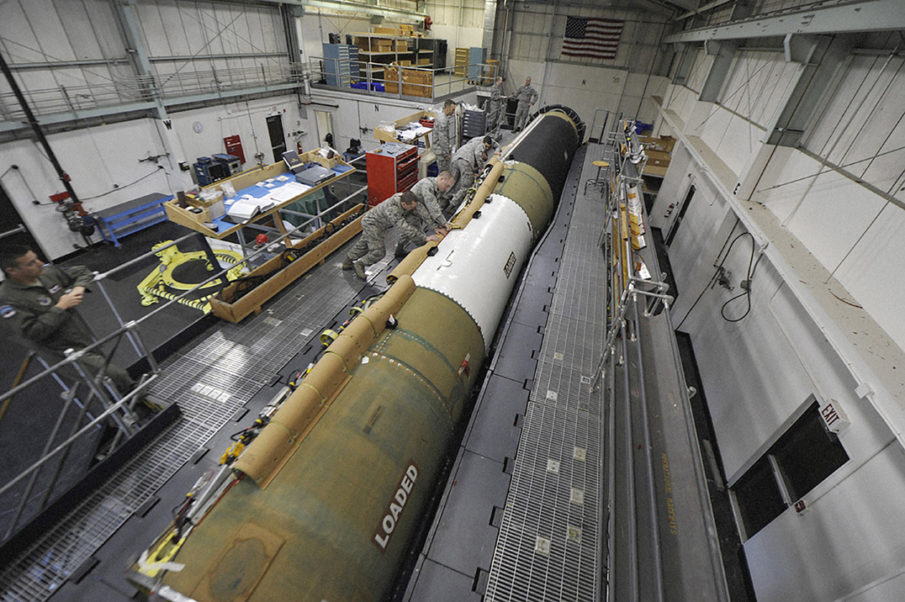In recent months, North Korea’s efforts to build and arm a nuclear-capable intercontinental ballistic missile have garnered significant attention, but it’s important to remember that Kim Jong-un isn’t the only nuclear player on the block. Another nation the United States has found itself butting heads with increasing frequency already possesses a massive nuclear stockpile (the largest in the world, in fact) and announced plans last year to begin fielding a more modern ICBM of their own: Russia. Worse still, if you remove the United States from the list of countries that have their own nuclear arsenals, the U.S. currently has strained, or worse, relations with half of them.
America’s growing emphasis on reliable missile defense systems, then, makes perfect sense, but the ability to shoot down an offensive nuclear launch is only half of America’s deterrent strategy. The other half, which dates back decades, is the concept of mutually assured destruction, or the promise that any nuclear attack would be met with an equivalent one, ensuring the utter destruction of all nations involved in a nuclear war.
The concept itself dates back to the 1870s, when English author Wilkie Collins wrote, “I begin to believe in only one civilizing influence—the discovery one of these days of a destructive agent so terrible that War shall mean annihilation and men’s fears will force them to keep the peace.”
To date, the United States has relied primarily on its stockpile of Minuteman III Intercontinental Ballistic Missiles, which have been operational since the 1970s. These missiles, and the systems that operate them, are almost comically outdated, and often rely on the 5.25” floppy disks many readers may recall using to play “The Oregon Trail,” back when computers will little more than big, noisy calculators.
That is, until now. The U.S. Air Force announced on Tuesday the awarding of two “technology maturation and risk reduction” contracts for America’s Ground Based Strategic Deterrent ICBM weapon system program. Boeing Company, out of Huntsville, Alabama, and Northrop Grumman Systems Corporation, out of Redondo Beach, California, will now be tasked with developing the missile platform that is to replace America’s seasoned Minuteman.
“We are moving forward with modernization of the ground-based leg of the nuclear triad,” said Secretary of the Air Force Heather Wilson. “Our missiles were built in the 1970s. Things just wear out, and it becomes more expensive to maintain them than to replace them. We need to cost-effectively modernize.”
Many high-ranking officials within the Defense Department have called for an overhaul of America’s nuclear triad in recent years. Aside from the outdated Minuteman III, the other two legs of the triad include missiles launched from B-52 bombers that first entered service in the 1950s, and submarine launched missiles. The intent behind maintaining such a “triad” is to ensure no offensive strike could eliminate America’s ability to respond with nuclear force.
The Minuteman III is the enduring ground-based leg of our nuclear triad. However, it is an aging platform and requires major investments to maintain its reliability and effectiveness,” said Gen. Robin Rand, the commander of Air Force Global Strike Command. “GBSD [Ground Based Strategic Deterrent] is the most cost-effective ICBM replacement strategy, leveraging existing infrastructure while also implementing mature, modern technologies and more efficient operations, maintenance and security concepts.”
The new contracts, each worth approximately $359 million, were awarded to the companies the Air Force says provided “the best overall value to the warfighter and taxpayers based on the source selection’s evaluation factors.”
Over the last year, we have executed a thorough and fair source selection while also putting in place the tools, infrastructure and analytic capability to execute the program. We are ready, excited and honored to begin working with our industry partners to develop and deliver an affordable, low-risk ICBM replacement, guaranteeing uninterrupted nuclear deterrence capabilities for the nation.” Col. Heath Collins, the AFNWC GBSD program manager, said.
It will likely be years before the GBSD missiles are able to replace the Minuteman IIIs currently tucked away in American silos, but the awarding of these contracts marks an important first step toward updating America’s first and second strike capabilities – despite the collective hope that they’ll never be needed in a combat scenario.
Already have an account? Sign In
Two ways to continue to read this article.
Subscribe
$1.99
every 4 weeks
- Unlimited access to all articles
- Support independent journalism
- Ad-free reading experience
Subscribe Now
Recurring Monthly. Cancel Anytime.
Image courtesy of the U.S. Defense Logistics Agency









